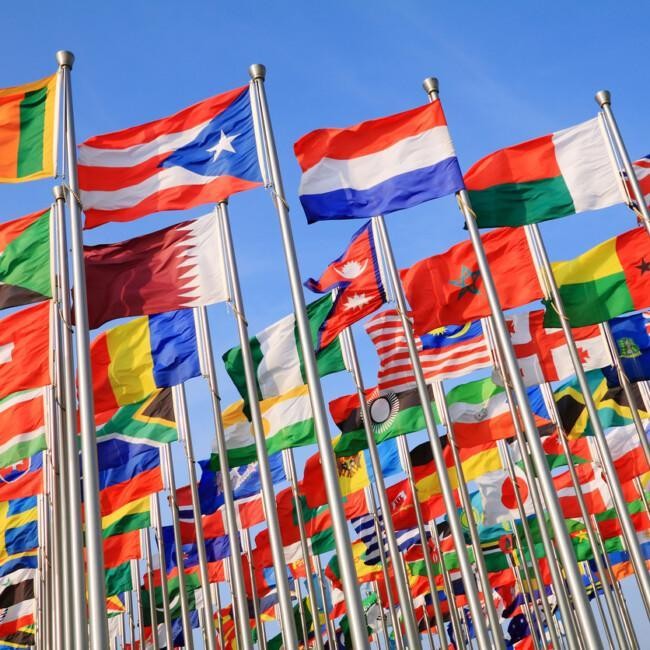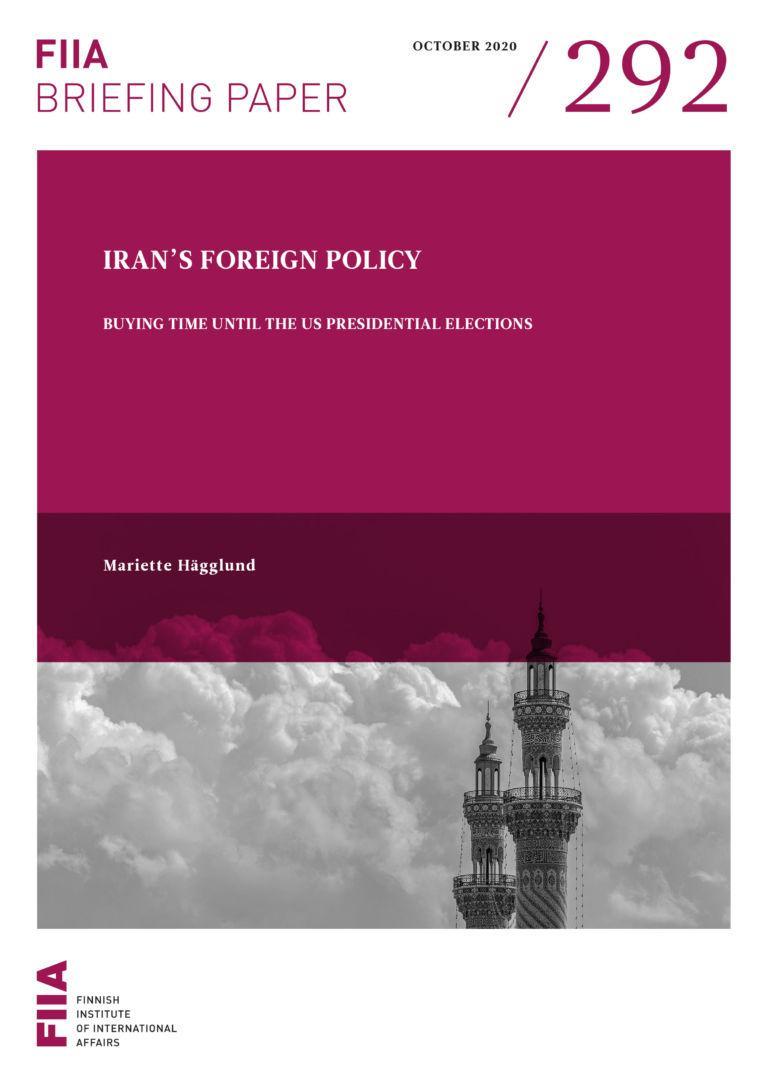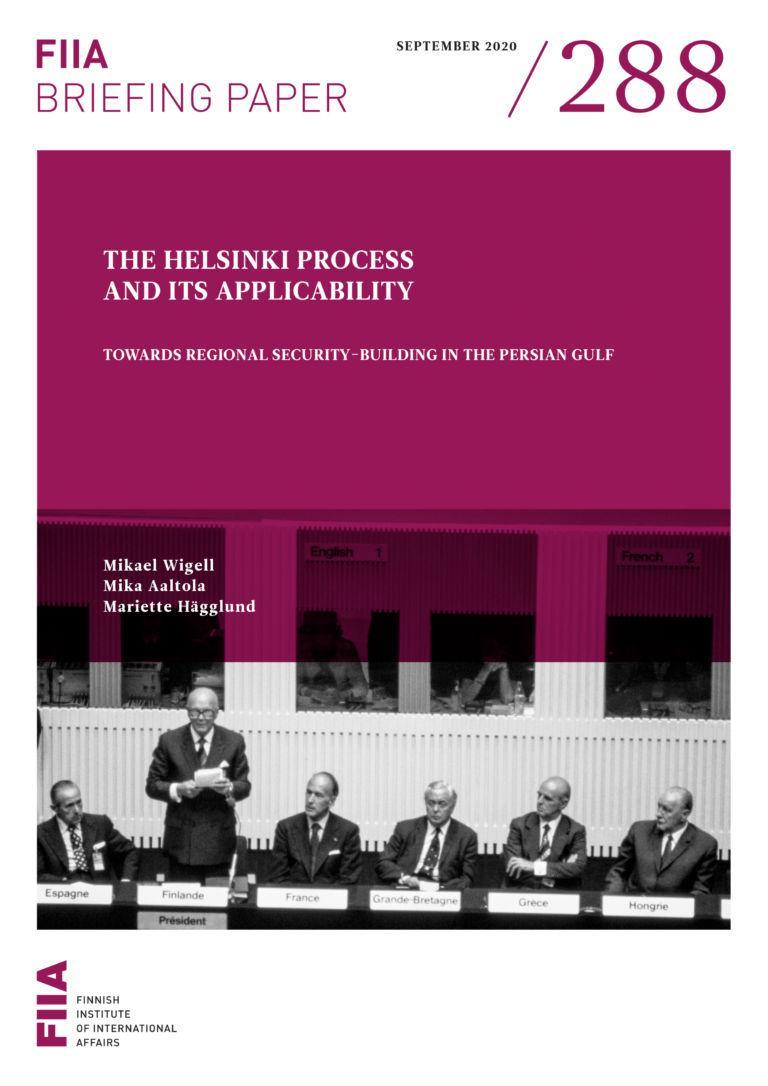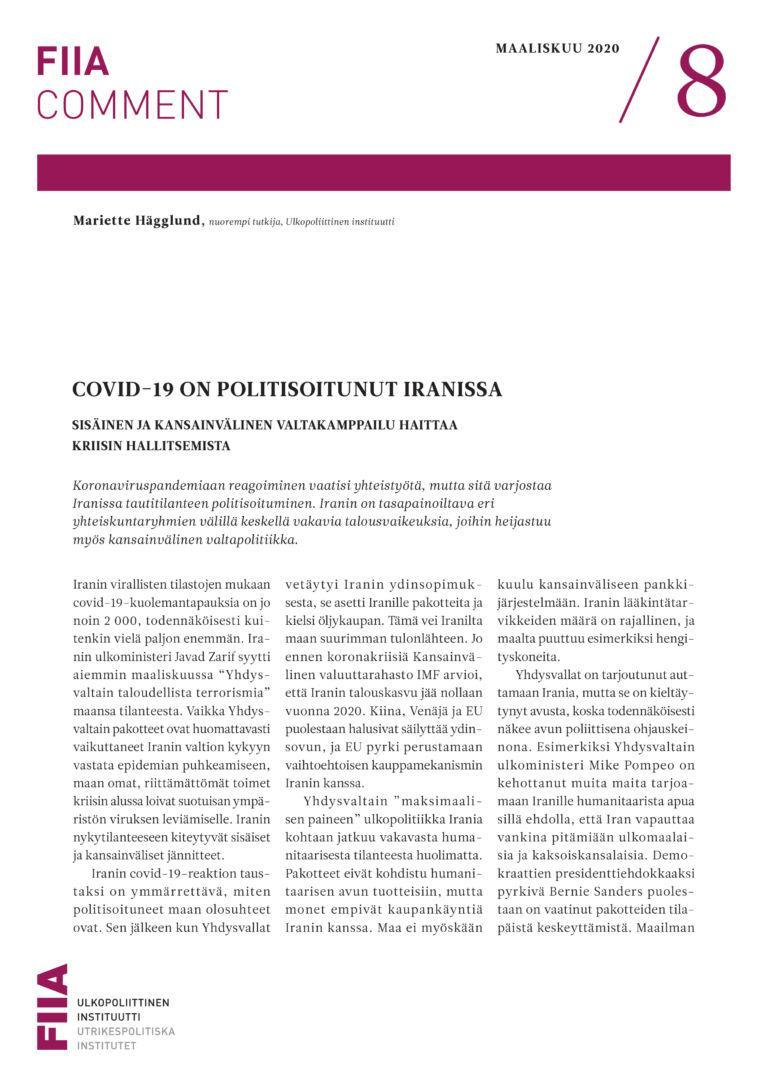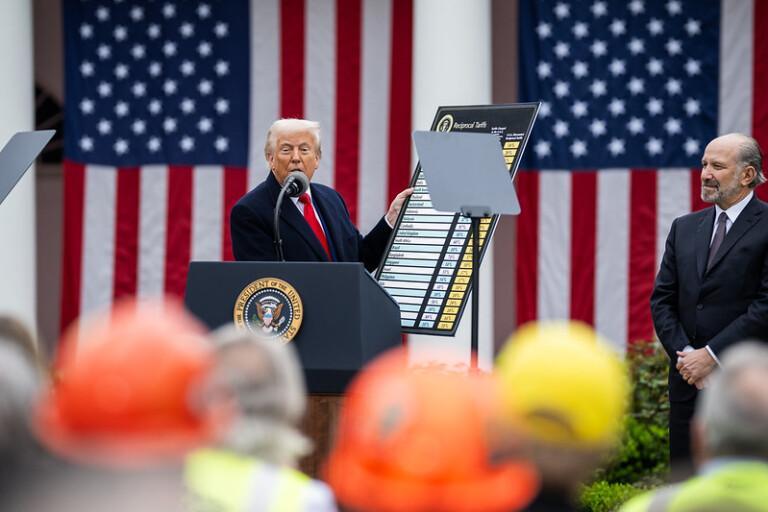
- A key issue dominating Iran’s foreign policy agenda is the future of the Iran nuclear deal with regard to the next US president.
- Non-state armed groups mark the core of Iran’s leverage in the region, but Iran is currently looking into diversifying its means of influence.
- Although Iran considers its non-aligned position a strength, it is also a weakness. In an otherwise interconnected world, where other regional powers enjoy partnerships with other states and can rely on external security guarantors, Iran remains alone.
- By being more integrated into regional cooperation and acknowledged as a regional player, Iran could better pursue its interests, but US attempts to isolate the country complicate any such efforts.
- In the greater superpower competition between the US and China, Iran is unlikely to choose a side despite its current “look East” policy, but may take opportunistic decisions.
Introduction
On October 18, it will be five years since the Joint Comprehensive Plan of Action (JCPOA) came into force. The initial optimism around the deal quickly evaporated in 2018 when President Donald Trump fulfilled his campaign promise to withdraw the US from the JCPOA and imposed harsh sanctions. Most recently, the US announced in September that it will trigger the JCPOA sanctions snapback mechanism amidst controversy over whether it still has the right to do so despite its withdrawal. It also imposed additional sanctions on Iran and demanded the EU to follow suit.
The domestic economic pressure within Iran following the sanctions has been massive and the large-scale protests in the autumn of 2019 epitomized popular grievances. In this new reality, Iran is trying to find ways to improve its regional and international negotiation position, while following the very principle of Iran as an Islamic theocratic republic. Its means to do so are, however, up for constant debate within Iran’s internal politics.
This Briefing Paper analyses Iran’s foreign policy through some of the key components shaping its behaviour. The paper uses these components to elaborate on how Iran views itself as a player in the broader regional and international system and looks at the likely path it will take in the greater superpower competition. It also discusses Iran’s means of influence, ranging from traditional diplomatic and economic cooperation to more subversive methods, such as the use of proxy groups.
Domestic political structure
Understanding Iran’s foreign policy requires looking at the power distribution between its political institutions. In essence, the power is vested in the supreme leader, who has the veto power in every decision. Based on an interpretation of the velayat-e (motlaqe-ye) faqih or Guardianship of the Jurist doctrine, clerical rule holds the supreme authority in the absence of the 12th Imam, lending the current supreme leader Ayatollah Khamenei considerable power. Consequently, the next supreme leader, if one is to be elected when Khamenei passes away, can significantly shape Iran’s future direction.
The supreme leader’s power is also built into the political system through the web of responsibilities. Iran’s political institutions can be divided into non-electoral and popularly elected bodies. For example, the president and the Iranian parliament, the Majles, are elected every four years. However, all candidates go through a strict vetting process by the Guardian Council, which holds considerable power traceable to conservative factions: its members are directly or indirectly nominated by the supreme leader. In the 2020 parliamentary elections the Guardian Council dismissed a third of the candidates, clearly favouring conservative or hardline candidates over so-called reformists or moderates (in reality, the political spectrum is much more complex). This further consolidated Khamenei’s power. When the Majles and Guardian Council are at odds regarding legislation, the Expediency Council, whom the supreme leader also appoints, arbitrates the disagreement. They may also leave them unresolved, which is what happened with the approval of anti-money laundering and terrorism financing legislation. Now Iran is on the Financial Action Task Force (FATF) blacklist together with North Korea.
Iran is torn between autonomy and engagement
Iran’s positioning vis-à-vis the international community remains a contentious topic in the country’s internal debate. On the one hand, according to moderates, Iran could better pursue its interests by being more integrated into international and regional cooperation. Iran’s foreign minister, Javad Zarif, has defined Rouhani’s foreign policy approach as being based on “realism, […] realistic idealism, and constructive engagement”.[1] Iran has attempted to engage with the international community, for example by joining the JCPOA, and has come up with its own regional security and dialogue initiatives, such as the Hormuz Peace Endeavour (HOPE). These efforts have been met with little enthusiasm by the Gulf states, whose interests lie in containing Iran while avoiding escalation. They have also been hindered by Trump’s attempts to isolate Iran.
On the other hand, Iran remains deeply sceptical towards the outside world. Its memories of foreign interference and injustice are still present in the official narratives, particularly among the conservative factions. Descriptive of this position is a post titled “115 years of nonstop crimes against Iran” on Khamenei’s website that lists various examples of ill treatment of Iran, ranging from UK oil exploitation in the early 20th century to US sanctions today.[2] For Iran, the first sign of US desire to become a global hegemon dates back to 1953, when Prime Minister Mossadeq was ousted in a coup orchestrated by the US and the UK. US partial support for Saddam Hussein in the Iran-Iraq war, presence in the Middle East, invasion of Iraq and Afghanistan, support for Iran’s rivals Saudi Arabia and Israel, and its withdrawal from the JCPOA has affirmed this view. Hence, the US is an actor that Iran should never cooperate with, in the view of these conservative factions.
Trump’s attempts to isolate Iran play into the internal debate between the various factions, but not necessarily the way the Trump administration envisages since it undermines the already limited moderate voices and boosts the hardline views. Still, amidst all the harsh language, there is room for restricted pragmatism on Iran’s part. The fact that the supreme leader approved the JCPOA also means he recognizes the benefits of international engagement – or at least appreciates the deal as a means to an end in giving Iran more leeway to expand its power. The question of how Iran should position itself internationally is not just about immediate national interest or the survival of the economy, but also about the very principles upon which the Islamic Republic is built.
Resistance economy as a propaganda tool
The slogan used by post-1979 Iran has been “Neither the East, nor the West, but the Islamic Republic” to portray its autonomous position in the international system. In an article for Foreign Affairs in 2014, Zarif noted that “Iran has remained independent from outside powers and practiced genuine nonalignment, lending it a particular freedom of action within the existing global order”.[3] In contrast to many of the Arab states allied with the US, Iran indeed sees that its independent position has given it more agency – for example to be the only state to truly support the Palestinian cause.
This position has, however, not been entirely voluntary. Partly based on Iran’s behaviour, particularly due to its revolutionary zeal in the 1980s, Shia Persian Iran has had difficulties establishing close ties in a region dominated by Sunni Arab states. Later on, its nuclear ambitions and support for the Assad regime and proxy groups have angered both the US and its regional allies. Now the Trump administration’s maximum pressure policy is isolating Iran against its will.
One of the goals for Trump has been to curb funding for Iran’s regime, and particularly for the Islamic Revolutionary Guard Corps (IRGC). Although sanctions have naturally hit the IRGC, his strategy has not been entirely successful. In some ways, it has even been counterproductive. Iran has been operating under various sanctions for decades and the IRGC has been in a position to try to circumvent them. Established in the early days of the revolution as a military branch functioning as a custodian of the ideas of the revolution, the IRGC gradually became a major economic player in Iran. Today, it is entrenched in Iran’s industry and political system. IRGC commanders hold senior positions, such as parliament speaker Mohammad Ghalibaf and secretary of the powerful Expediency Council, Mohsen Rezaee.
Now US sanctions have targeted most major industries in Iran, such as oil, construction and mining. In response, Khamenei reinstated the so-called “resistance economy” in 2019, originally introduced in 2013. It refers to greater self-sufficiency, reducing the dependence on oil revenues and foreign resources, and diversifying to non-oil products and exports. Critics have said it is only a tool to circumvent sanctions, that it justifies the grey economy and smuggling, and actually benefits many of the industries controlled by the IRGC. Since the latter owns a large part of Iran’s domestic industries, the calls for resistance economy also mean that domestic production will fall into the hands of the IRGC. Conservative elements in the government and the IRGC have also been the loudest proponents of resistance economy.[4]
Meanwhile, insufficient success in boosting the economy has been blamed on Rouhani, not the sanctions. Since Iran’s economy is a mixture of market economy and domestic production, its resistance economy is more of a propaganda tool and will neither make Iran economically independent nor address grievances within the country. While the lifting of sanctions would bring relief to the larger society compared to the current sanctions policy, the IRGC benefits in both instances.
Looking to the East
Although Iran considers its independent position a strength, it is also a weakness. In an increasingly interconnected world, where regional powers have established partnerships with other states and rely on external security guarantors, Iran remains relatively alone.
The European Union sees both market potential and security concerns in Iran and has tried to mediate amidst the US-Iran enmity. With the so-called 2015 migration crisis in mind, the EU wants to avoid any kind of escalation in its vicinity that could de-stabilize the country or the region. The EU wants a non-nuclear Iran and it has sided with Russia and China in backing the JCPOA, but its agency has nevertheless proven limited. By launching the alternative trading mechanism INSTEX the EU has attempted to keep Iran committed to the deal, but this has been viewed more as a political gesture than a functioning economic tool. While the EU has opposed the triggering of the snapback mechanism and US claims to be a participant of the JCPOA, Iran has tried to exert pressure by violating the accord and show force with its missile programme.
Recently, Iran has increasingly been shifting its slogan towards the “look East” policy, which basically incorporates China and Russia. Both of them have voted against or abstained from voting in United Nations Security Council and International Atomic Energy Association (IAEA) resolutions. Moreover, they had a joint military drill in 2019 and blocked the extension of the arms embargo, from which they are also the ones with the most to gain.
Both Russia and Iran wanted to keep Bashar al-Assad in power in Syria, and Iran even temporarily let Russia use its Hamadan airbase. Despite some common interests, however, the relationship with Russia is marred by historical difficulties, ranging from the injustice experienced with bilateral treaties in the 19th century to the threat posed by the Soviet invasion of Afghanistan.
China, on the other hand, provides Iran with an attractive option. China’s long independent history, its policy of non-intervention and ideological opposition against the US provides Iran with many incentives to deepen the relationship. Besides opposing US actions, China remains one of Iran’s largest trading partners. Iran is strategically located along China’s Belt and Road Initiative (BRI) route, has substantial energy reserves and is a potential market base.
The nature of China, seen from Iran as a communist, atheist state, and its troublesome record with the Muslim Uyghurs in the country, has not hindered Iran from wanting closer contact with China. Its increasing influence and the potential debt trap in other countries is, however, followed with suspicion. Iran’s constitution specifically mentions that “any form of agreement that would result in foreign domination over the natural and economic resources, […] over culture, the army, and other affairs of the country, is forbidden”.[5] Some conservative factions criticized the Comprehensive Strategic Cooperation agreement signed with China in the autumn of 2019 for endangering Iran’s sovereignty. Simultaneously, however, conservative factions have also hailed the deal as a threat to Western interests and have propagated closer ties with the East. The IRGC has long been dealing with China, and the IRGC-owned Mahan Air continued its flights to China despite Covid-19. Hence, the engagement-isolation question boils down to a complex internal power play. Depending on the nature of the cooperation and China’s presence, the IRGC could risk losing some of its industrial power. Either way, it would be an unprecedented move if Iran were to approve some form of presence in the country.
China has overlooked traditional divisions in the Middle East and has established partnerships not only with Iran, but also with Saudi Arabia and Israel. Unlike Saudi Arabia and Israel, Iran is not a US ally, but only in Iran is China constrained by sanctions and will remain so as long as the global financial system is dollar-based. China may engage with Iran and use its influence when provided with a good opportunity, but ultimately its policy is driven by economic and national interests. Hence, Iran cannot count on China for unconditional support. Iran needs to engage with the West to improve its chances of obtaining sanctions relief and keeping the JCPOA alive, which in turn would enable increased cooperation with China. Thus Iran is not likely to choose a side in the greater superpower competition – at least not yet.
Justly interfering in the neighbourhood
Iran’s constitution outlines that “while [Iran] completely abstains from any kind of intervention in the internal affairs of other nations, it supports the struggles of the oppressed for their rights against the oppressors anywhere in the world”.[6] Since Iran sees injustice and domination almost everywhere, it will continue, in its own view, to have a legitimate reason to interfere, even if its actions actually boil down to self-interest.
Iran’s position as a supporter of the oppressed is ingrained in its identity as the Islamic Republic of Iran, and specifically as the world’s only Shiite state. This dates all the way back to the Battle of Karbala in 680 when Imam Husayin was martyred by Yazid in the contestation about the rightful leader of Islam, which divided Islam into Sunni and Shiite denominations. According to the founder of the Islamic Republic of Iran, grand Ayatollah Khomeini, Imam Husayin’s death, annually commemorated particularly among Shiites, represented a battle against tyranny. For Khomeini, this pattern was repeated in the secularized monarchy represented by US ally Shah Reza Pahlavi, which led to the popular revolution in 1979.
Iran has used this position to justify interference for decades. In the early 1980s, Iran started supporting Hezbollah against the Israeli occupation in Lebanon. After the US invasion of Iraq in 2003, Iran gradually filled some of the power vacuum by supporting groups that resisted US occupation. When the Arab spring protests in 2011 challenged Bashar al-Assad in Syria, Iran quickly came to the rescue of its long-standing ally. Moreover, Iran started supporting the Houthis in the civil war in Yemen that erupted in 2015. If similar opportunities to fill power vacuums or support internal dissent in neighbouring countries emerge, Iran may well utilize them.
[caption id="attachment_103451" align="aligncenter" width="300"] Map: Iran's regional allies[/caption]
Map: Iran's regional allies[/caption]
Proxy groups at the core of Iran’s regional activities
With the exception of Syria, Iran’s allies consist of non-state or proxy groups. The IRGC’s external branch Quds forces are the main faction responsible for coordinating support for them. Through them, Iran has been able to “reject domination” while simultaneously increasing its influence. Iran presents itself as the protector of both Islam and Shia Islam. To legitimize its support and to mobilize its various proxy groups, Iran has indeed often used a co-religionist narrative of “merging and unity of the Muslim nations”.[7]
Iran has the strongest support among groups following the official denomination of Iran, Twelver Shiism, and who also approve of the velayat-e faqih doctrine. These include Lebanese Hezbollah and some of the most adamant pro-Iran militias part of the Popular Mobilization Forces in Iraq, such as Kata’ib Hezbollah, Asa’ib al Haq and the Badr Organization. Many other PMF militias, however, reject the doctrine and instead follow grand Ayatollah Ali al-Sistani, the leading Shia marja in Iraq. In contrast to Khamenei, quietist Sistani rejects the absolute power of velayat-e faqih and rarely gets involved in politics.
The Zaydi Shia Houthis in Yemen and Assad’s Alawite minority rule in Syria are also categorized within Iran’s Shiite allies. The IRGC has reportedly recruited refugees and undocumented Afghans in Iran in exchange for residency and/or financial compensation as well as among the Shiite minority in Afghanistan and Pakistan. Together they form the so-called Zainabioun and Fatimayoun Brigades. Their names represent their official mission to defend the holy shrines of Zainab and Fatima in Syria, but their purpose is largely political. Iran’s support has also extended beyond its theological doctrine to Sunni groups such as Hamas and Palestinian Islamic Jihad. Both are listed as terrorist organizations by the EU, as is Hezbollah’s military wing. The Trump administration has criticized the JCPOA for not dealing with Iran’s ballistic missiles programme and has expressed concern that the removal of the arms embargo will improve Iran’s possibilities to sell or transfer weapons to these groups.
There are constant debates on the extent to which the proxy groups act in coordination with Iran. When a drone strike targeted Saudi Aramco’s facilities and cut the country’s crude oil production in half, Saudi Arabia accused Iran while the Houthis took the blame. Similarly, the level of coordination between Iran and the PMF has been debated, even more so after the US killed IRGC Quds Qassem Suleimani in January this year since much of the influence was personified in him. When Hamas sided with the opposition in the Syrian civil war, the relationship with Iran deteriorated. Palestinian Islamic Jihad, on the other hand, sided with Assad, and thus enjoyed more stable support from Iran. These nuances are reminders of the fact that although Iran supports these groups and can use them to mask its own activities, they do not act in symbiosis.
Diversifying means of influence
A dominant view is that if Iran wants to become the regional or international power it views itself as, it has to sustain and diversify its means of influence. Although proxies have been useful to put pressure on the US and its allies, Iran is looking into alternative solutions. Having seen the expanding influence of Saudi Arabia and Turkey beyond the Middle East, there have been calls in Iran to utilize its soft power more ambitiously.
To make its influence more sustainable, Iran will likely want to institutionalize its power and partly turn the militias into political parties, following the example of Hezbollah, which developed from a resistance movement into a “state within a state”. This has been achieved to some extent in Iraq after the Fatah coalition – consisting of political groups with many pro-Iran militia members – came second in the Iraqi parliamentary elections in 2018. In this way, Iran could remain influential through legitimate means even if the militias were officially demobilized. The current challenge is rather nationalistic in nature, as there is significant opposition among Iraqis and Lebanese against Iran’s influence.
In the hope of keeping its options open, Iran is quite unlikely to act beyond a point of no return. Hence, when the US killed Suleimani, Iran ended up avenging his death restrainedly, causing traumatic brain injuries but no casualties. Before Iran’s retaliation, the US warned about potential cyberattacks conducted by Iran on critical national infrastructure.[8] Iran’s own cyber capabilities have been said to have increased in the aftermath of the 2010 Stuxnet computer worm. According to the cyber security company F-Secure, the “Iranian regime has demonstrated greater appetite towards destructive or disruptive cyber-attacks in peacetime than any other nation”, using the Shamoon virus in 2012 and its reappearance in 2016 as examples.[9] This spring, Israel and Iran blamed each other for cyberattacks against critical infrastructure and in August the US accused Iran for trying to “undermine US democratic institutions [and] President Trump”[10]. Iran likely wants to improve its capabilities, both for deterrence and disruption, and their deniability also makes them more attractive.
Conclusion
Ever since its inception, the Islamic Republic of Iran has praised its nonalignment in the region. It has tried to balance between the major powers, while not – officially – letting itself become dependent on a single one. However, the sanctions have shown that the mixture of Iran’s resistance economy and market economy are dependent on and vulnerable to outside changes.
There is a constant debate within Iran on how to engage, which side to choose in the larger superpower competition, or whether a choice is even necessary. The combination of its own desire to be an autonomous player and Trump’s isolationist attempts has pushed Iran towards Russia and China, which are expanding their presence in the region.
In a position where it sees most of the world as unjust and under domination, from its own perspective Iran has a legitimate reason to interfere almost anywhere. It is likely to continue developing its leverage, through proxy groups, cyber capabilities or soft power, but will do so from a position where it can avoid attribution or keep the repercussions limited. The way in which it does this will be determined by the interplay between and within the various factions in Iran’s domestic politics, including the IRGC, and ultimately by Khamenei. Currently, it still wants to keep its options open.
Amidst increasing pressure from the US, Iran is buying time until the US presidential election in November. It will not only influence how and in which direction Iran will aim to engage, but may also determine the fate of the JCPOA. Considering the EU’s geopolitical realities, currently lacking its traditional support from the US and recognizing the common ground between Russia, China and Iran, a more pro-West Iran would be in the EU’s interest. The EU should already sow the seeds for the aftermath of the US election, irrespective of the results, in order to have leverage vis-à-vis Russia and China.
Endnotes
[1] Zarif, J. (2014). What Iran Really Wants, Foreign Affairs, May/June 2014, https://www.foreignaffairs.com/articles/iran/2014-04-17/what-iran-really-wants.
[2] Khamenei.ir, 115 years of nonstop crimes against Iran, https://english.khamenei.ir/subject/2241/115-years-of-nonstop-crimes-against-Iran.
[3] Zarif, J. (2014). What Iran Really Wants, Foreign Affairs, May/June 2014, https://www.foreignaffairs.com/articles/iran/2014-04-17/what-iran-really-wants.
[4] Majidyar, A., (2018). IRGC's role in Iran's economy growing with its engineering arm set to execute 40 mega-projects, Middle East Institute, 7.5., https://www.mei.edu/publications/irgcs-role-irans-economy-growing-its-engineering-arm-set-execute-40-mega-projects.
[5] Constitution of the Islamic Republic of Iran, https://www.wipo.int/edocs/lexdocs/laws/en/ir/ir001en.pdf.
[7] Ibid.
[8] US Department of Homeland Security (2020). National Terrorism Advisory System Bulletin, January 4,
https://www.dhs.gov/sites/default/files/ntas/alerts/20_0104_ntas_bulletin.pdf.
[9] Parsons, E. and Michael, G., Understanding the Cyber Threat from Iran, F-Secure, https://www.f-secure.com/en/consulting/our-thinking/understanding-the-cyber-threat-from-iran.
[10] US National Counterintelligence and Security Center (2020). Statement by NCSC Director William Evanina: Election Threat Update for the American Public, August 7, https://www.odni.gov/index.php/newsroom/press-releases/item/2139-statement-by-ncsc-director-william-evanina-election-threat-update-for-the-american-public.

